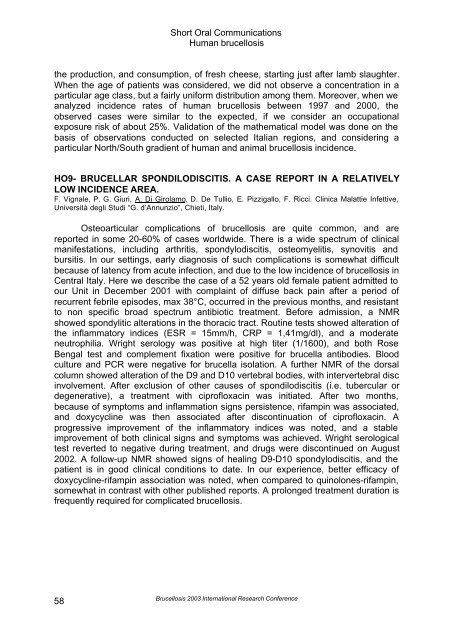Brucellosis 2003 proceedings - PHIDIAS
Brucellosis 2003 proceedings - PHIDIAS
Brucellosis 2003 proceedings - PHIDIAS
Create successful ePaper yourself
Turn your PDF publications into a flip-book with our unique Google optimized e-Paper software.
Short Oral Communications<br />
Human brucellosis<br />
the production, and consumption, of fresh cheese, starting just after lamb slaughter.<br />
When the age of patients was considered, we did not observe a concentration in a<br />
particular age class, but a fairly uniform distribution among them. Moreover, when we<br />
analyzed incidence rates of human brucellosis between 1997 and 2000, the<br />
observed cases were similar to the expected, if we consider an occupational<br />
exposure risk of about 25%. Validation of the mathematical model was done on the<br />
basis of observations conducted on selected Italian regions, and considering a<br />
particular North/South gradient of human and animal brucellosis incidence.<br />
HO9- BRUCELLAR SPONDILODISCITIS. A CASE REPORT IN A RELATIVELY<br />
LOW INCIDENCE AREA.<br />
F. Vignale, P. G. Giuri, A. Di Girolamo, D. De Tullio, E. Pizzigallo, F. Ricci. Clinica Malattie Infettive,<br />
Università degli Studi “G. d’Annunzio”, Chieti, Italy.<br />
Osteoarticular complications of brucellosis are quite common, and are<br />
reported in some 20-60% of cases worldwide. There is a wide spectrum of clinical<br />
manifestations, including arthritis, spondylodiscitis, osteomyelitis, synovitis and<br />
bursitis. In our settings, early diagnosis of such complications is somewhat difficult<br />
because of latency from acute infection, and due to the low incidence of brucellosis in<br />
Central Italy. Here we describe the case of a 52 years old female patient admitted to<br />
our Unit in December 2001 with complaint of diffuse back pain after a period of<br />
recurrent febrile episodes, max 38°C, occurred in the previous months, and resistant<br />
to non specific broad spectrum antibiotic treatment. Before admission, a NMR<br />
showed spondylitic alterations in the thoracic tract. Routine tests showed alteration of<br />
the inflammatory indices (ESR = 15mm/h, CRP = 1,41mg/dl), and a moderate<br />
neutrophilia. Wright serology was positive at high titer (1/1600), and both Rose<br />
Bengal test and complement fixation were positive for brucella antibodies. Blood<br />
culture and PCR were negative for brucella isolation. A further NMR of the dorsal<br />
column showed alteration of the D9 and D10 vertebral bodies, with intervertebral disc<br />
involvement. After exclusion of other causes of spondilodiscitis (i.e. tubercular or<br />
degenerative), a treatment with ciprofloxacin was initiated. After two months,<br />
because of symptoms and inflammation signs persistence, rifampin was associated,<br />
and doxycycline was then associated after discontinuation of ciprofloxacin. A<br />
progressive improvement of the inflammatory indices was noted, and a stable<br />
improvement of both clinical signs and symptoms was achieved. Wright serological<br />
test reverted to negative during treatment, and drugs were discontinued on August<br />
2002. A follow-up NMR showed signs of healing D9-D10 spondylodiscitis, and the<br />
patient is in good clinical conditions to date. In our experience, better efficacy of<br />
doxycycline-rifampin association was noted, when compared to quinolones-rifampin,<br />
somewhat in contrast with other published reports. A prolonged treatment duration is<br />
frequently required for complicated brucellosis.<br />
58<br />
<strong>Brucellosis</strong> <strong>2003</strong> International Research Conference
















